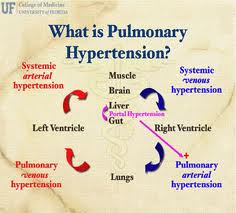Regardless of underlying cause or associations, several inter related mechanisms play a role in the development and maintenance of PAH. These mechanisms are mediated by one or more molecular and cellular processes, including reduced prostacyclin availability due to diminished endothelial cell prostacyclin synthase activity, elevated endothelin levels resulting from enhanced production and reduced pulmonary clearance, decreased nitric oxide synthase expression, elevated plasma and low platelet 5-HTT levels, down regulation of voltage dependent potassium Kv1.5 channels of pulmonary vascular smooth muscle cells, activity of autoantibodies and pro-inflammatory cytokines and prothrombotic states arising from endothelial, coagulation and fibrinolytic cascade and platelet dysfunction.
The result of these abnormalities gives rise to a predisposition of vasoconstriction
over vasodilation of the pulmonary vasculature, to excess cellular proliferation which
outpaces apoptosis and to a thrombotic diathesis. The occurrence of dynamic increase
of pulmonary vascular resistance appears to be an early substrate of PAH, with intimal
hyperplasia due to endothelial cell proliferation, medial thickening due to vascular
smooth muscle cell proliferation, development of plexiform lesions caused by disordered
endothelial proliferation, and thrombosis becoming more prominent during the clinically
apparent stages of the disease.
Appreciation of the underlying mechanisms of disease points to the means by which
pharmacologic treatment can be utilized to counteract their consequences. The
management of patients with PAH consists of first identifying the presence of PH and
then defining the precise clinical context of the abnormal hemodynamic state, including
the severity of problem, the associated or casual conditions, the functional implications,
and the prognosis. This information is required in order to design the optimal therapeutic
The basic diagnostic strategy, therefore, is to screen for PH in symptomatic or high
risk patients, then to systematically examine potential underlying conditions with
appropriate tests, delineate predictive factors, perform functional assessment, and to
confirm the hemodynamic profile by invasive testing. There are symptoms which
require consideration of PH, findings on physical examination which are important for
detecting PH and guiding further evaluation. Although no current treatment of PAH can
be considered curative, realistic goals of treatment are to reduce pulmonary vascular
resistance and pressure, diminish symptoms and promote activity tolerance and prolong







